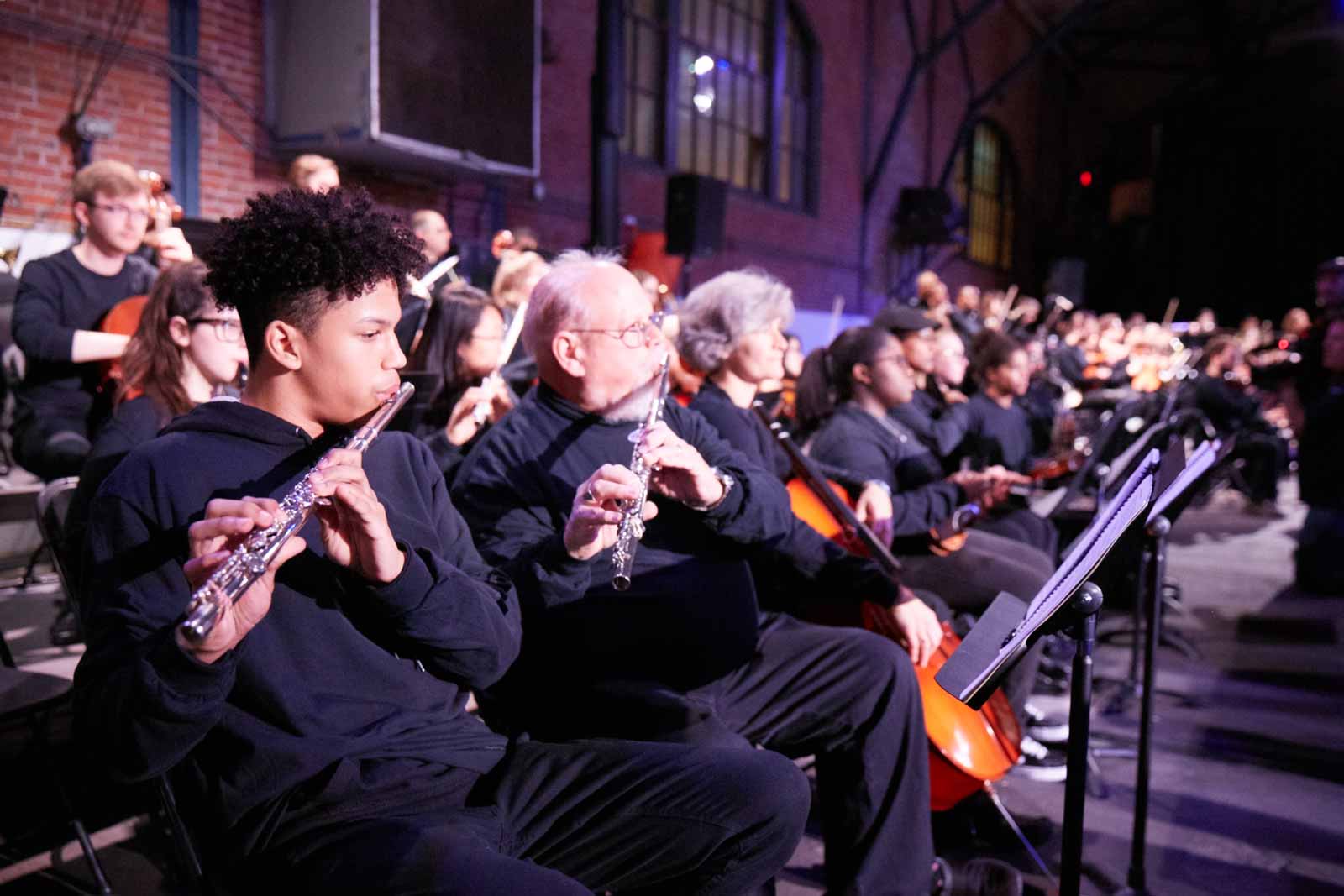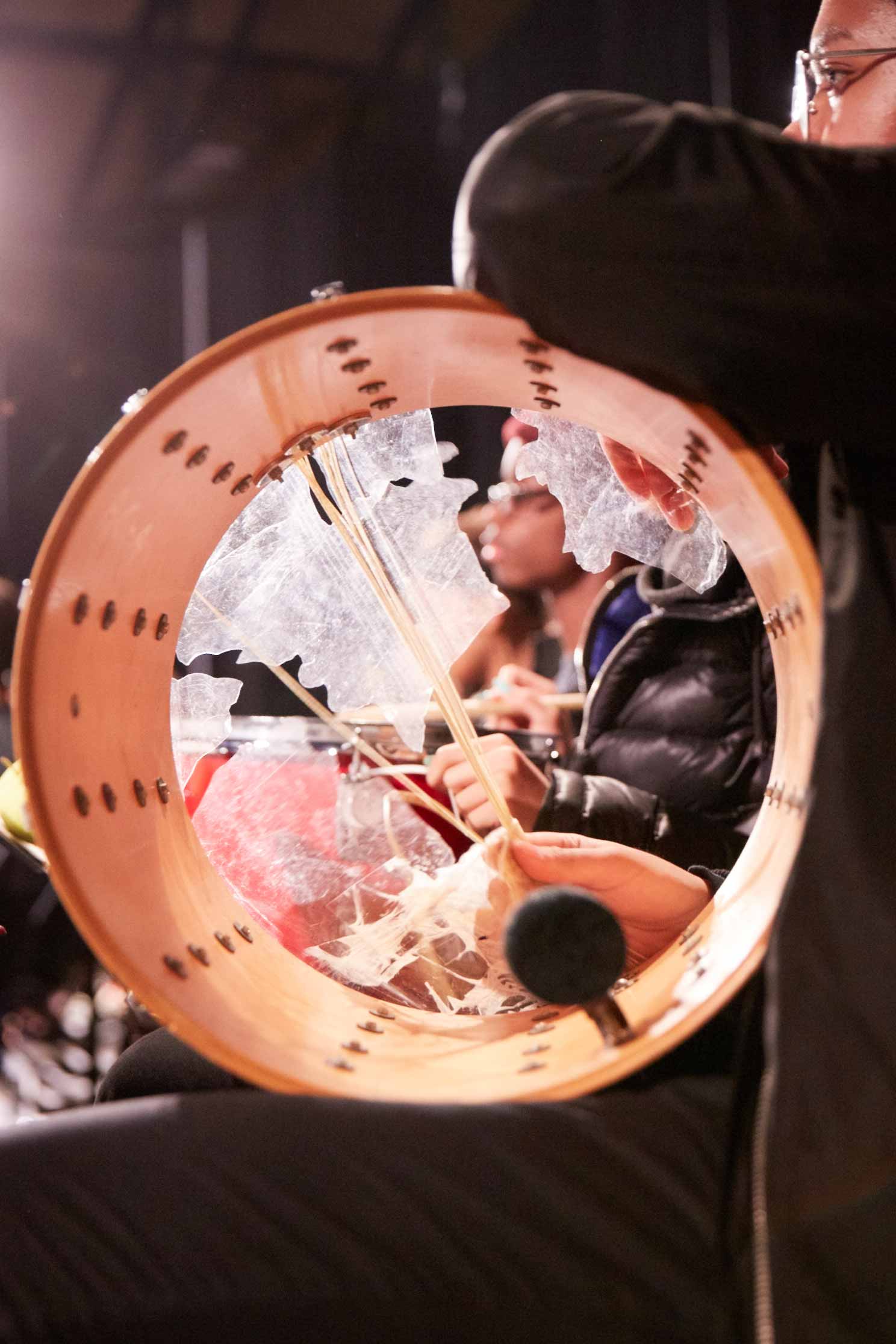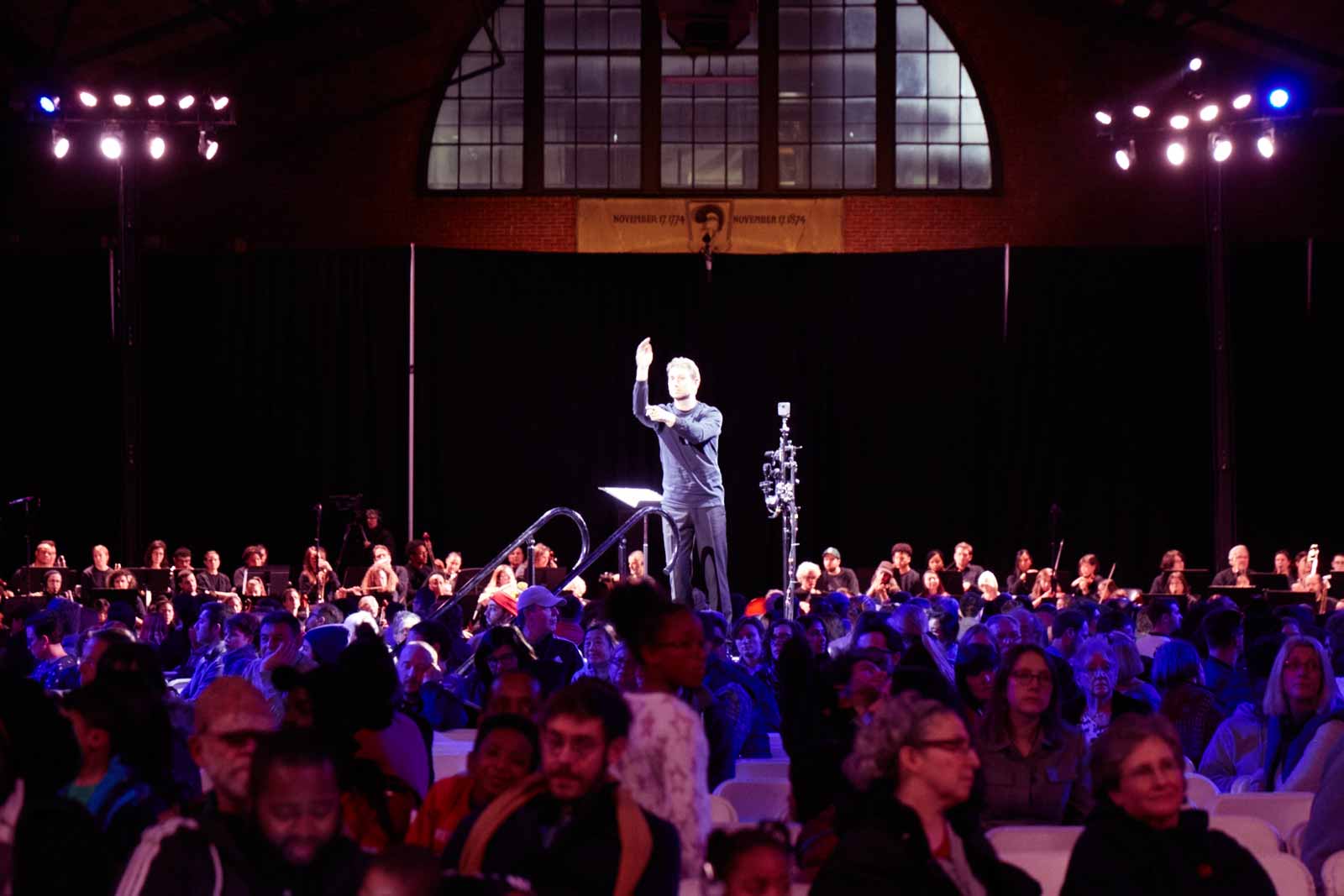A little boy was snapping broken strings against his cello. The man in front of him produced a rattling noise by frantically inserting and removing his trumpet’s mouthpiece. To their left, an intent woman’s bow-strings dangled like shredded spider webs across the face of her violin. Taken individually, any one of these people would have simply seemed unusual. But together, this orchestra of four hundred amateurs, students, and professionals was forging something unique, a new symphony that was at once significant and ephemeral. Not just in the sense of the eerie, often beautiful sound they produced with their misfit tools, but because the instruments themselves would soon disappear.
They had gathered in the 23rd Street Armory in Philadelphia to perform David Lang’s remarkable Symphony for a Broken Orchestra. The piece was developed with Robert Blackson, the director of Temple Contemporary at the Tyler School of Art, which had collected over a thousand damaged instruments from Philadelphia’s public schools. Lang wrote a score to accommodate their infirmities. Visitors to the project’s website can listen to each individual instrument—an often melancholy experience—and donate to adopt a favorite one. The instruments will be repaired and returned to the school system next year, their cases now bearing tags with the names of their benefactors. The symphony was the only opportunity to hear them in their broken state.
Given the instruments’ defective condition, Lang told me, consistency was impossible. Each run-through was different, and the musicians had to improvise as they went. As we gathered before the show, the question, standard with this sort of thing, was more pressing than usual: Would we feel good about the artwork, or would the art do the work of making us feel good?
The players that night in the Armory were volunteers, ranging from Philadelphia Orchestra members to community musicians to school children. As they entered, some sheepish, some professional, others clearly delighted, there was a voyeuristic, rubbernecking thrill in discovering exactly how their instruments were broken. The sun setting through the large overhead window lit these implied stories in miniature: a hole in a drum, a rambunctious child; a dented trombone, a fall down the stairs; snapped strings, a perfectionist, running scales one time too many. The audience sat in concentric circles in the center of the large room, and the musicians surrounded us, divided up in bleachers into sections of about thirty players apiece, each group chosen with both ability and diversity in mind.
This subjective, personalized experience of the performance is characteristic of Lang’s recent work. Though he is perhaps best known for lush pieces like the Pulitzer Prize-winning oratorio Little Match Girl Passion and minimalist early works like The Passing Measures, he has recently moved toward a more deconstructed, egalitarian approach. His Crowd Out featured about a thousand screaming people in an atrium in Birmingham, England, and, as Francine Prose pointed out here last year, the “unusual staging” of his excellent operatic adaption of a Thomas Bernhard novel, The Loser—with attendees restricted to the mezzanine, and the lone singer on a raised platform directly in front of them—placed the audience in “an intimate sort of proximity to the narrator.”
Then, an uncanny rupture. To my left was a musician named Joe Kille, with whom I’d gone to college. I had last seen Joe in 2014, playing the fiddle at a wedding near Johannesburg in South Africa. We made brief, startled eye contact, but then the music started. At first, there was only rattling. Every instrument is capable of being played as percussion. The players seemed giddy as their cricket-chirping sound built up. A large man cradled his cello, which lacked both strings and neck, in his arms.
The conductor was positioned on a platform in the center of the audience. He cued in one section at a time, louder and louder, like the wave at a baseball game. “Usually,” Blackson told me, “all you’re going to see is the conductor’s butt… our showcase is the musicians.” It was difficult to watch him for long, because the larger spectacle of the performance was so unusually captivating. As the rustling came and went like summer rain, all those hands moved at once, moved differently. A woman drummed her fingers across a viola’s back. A trumpet player was now shaking his wrist in his instrument’s bell as if he was beating eggs with the mouthpiece.
Advertisement
Then a flute played—on pitch, an impressive surprise—and the woodwinds came in soon after, and the scale of the damage to the instruments became clear as their players struggled to produce clear tones. Volume began to mask individual flaws as Lang’s elegiac droning pitched up and down. A child tapped on a violin that lacked a scroll; only the strings held his kindling together. Instruments sound more human when they are imperfect. It was like listening to a choir.
There was a pause before the symphony’s second movement started. Section leaders began a rhythmic call-and-response within each thirty-person group, a conversation among their fellows that soon evolved into melodies swapped back and forth. These leaders were chosen for their connections with the Philadelphia music community, and they had a great deal of freedom in their decision-making. Although Lang had written a variety of options for them, he trusted them to listen to their collaborators and adjust to their instruments on the fly. Gradually, everyone began playing at once, louder and louder, in short, staccato bursts. The sound intensified until it verged on painful.
Finally, the man with the broken trumpet began to blow, signaling the third and final movement of the fifty-minute performance. This was the most beautiful, lyrical, chord-based section, and as their flawed machine began to soar triumphant, I forgot that these instruments were broken. The orchestra’s crescendo stretched on until the piece closed with a few notes from a single clarinet player, fragile in that huge space. We stood to applaud, and the musicians did, too. There was a palpable happiness in their achievement, in what they had illuminated.
Every damaged instrument that night represented an irreplaceable loss, a child who had been denied a musical voice. Like many American school districts, Philadelphia has suffered from destructive cuts to arts program funding, and the students who were most affected, as Blackson pointed out to me, live in low-income areas. In 2007, the district’s budget for arts programs had been $1.3 million; in 2015, it was $50,000. School children are forced to share the few instruments that work, and desperate teachers have long hoarded these damaged goods, hoping that they would somehow be repaired. Temple Contemporary has already raised over $200,000 for this cause, a fund that will also pay to replace instruments that are beyond saving.
After the performance, an ebullient Blackson shouted out, “These are the best broken instruments in the district, baby!” It was the day after the Senate tax reform bill had passed, and Lang also asked, more somberly, given the “preferencing of private schools over public education, who’s ever going to want to give the money to repair these instruments?” Citizens, Lang went on to say, “will have to find the things they believe in and invent reasons for people to get up and save them.”
I caught up with my old classmate, Joe Kille. His mother had been in the orchestra, too, playing violin; they seemed both tired and thrilled. On the way home, as I read through the program, I saw that he’d adopted his instrument in honor of her.
David Lang’s Symphony for a Broken Orchestra was performed on December 3 at the 23rd Street Armory in Philadelphia.






